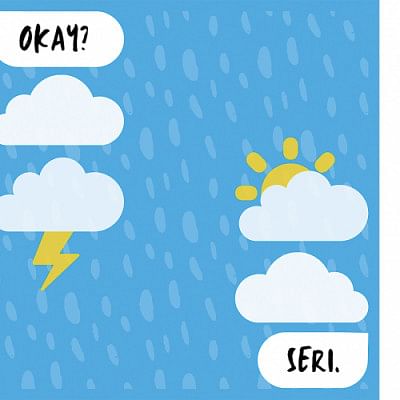Bollywood’s ‘The Fault in Our Stars’: Okay? Not Okay?

From my early teenage years, until I was 16, I was only allowed to take up pastime reading on holidays. Throughout the school term, I would look for books that called to me and add them to my list. Around the end of every term, I would hand the list to my father, who would then trade it in for a stack of novels the second I stepped home after the last exam for the term.
The Fault in Our Stars made it onto my list early in the summer of 2014 due to a simple, self-given rule: If I wanted to watch a movie that was adapted from a book, I had to read the book first. So, I sped through the book in two days, determined to watch the movie as soon as possible. Boy, was that a mistake.
Even after mindlessly skimming through the novel, I could tell that the Hollywood adaptation had not this masterpiece justice. Now, almost eight and a half years after its publication, after Bollywood has just released its own version of TFIOS, I find myself on the same boat.
When TFIOS first released, it brought on such a powerful surge of change, not only in our reading lists, but in our perception of terminal and mental diseases and even to the genre itself, which was notorious for its similar plot and sugar-coating—Nicholas Sparks' A Walk to Remember (1999) comes to mind. Green breathed fresh air by modernising the age-old plot of star-crossed lovers, attracting readers of all ages from around the globe.
For those who don't know, TFIOS was John Green's tribute to 16-year-old Esther Earl, one of the first members he befriended from his vlogging community. Esther was suffering from cancer and died soon before the novel was penned. Green used his experience with Esther to ensure that his text was as authentic as possible in portraying the sufferings of those suffering from cancer.
Inspired by Esther, John Green created Hazel Grace Lancaster, a 16-year-old battling thyroid cancer. Hazel has difficulty socialising with people her age, until she meets Augustus Waters at a cancer survivors' support group. By the time fate caused them to collide, Hazel Grace had already suffered for three years and Augustus had gone into remission after losing his right leg to osteosarcoma (bone cancer). The two are immediately drawn to each other and a heart-wrenching story of friendship, love and loss begins.
Even without the characters' terminal illnesses or perhaps because of them, TFIOS stands out among other romance novels of its time. For one, John Green's characters aren't stereotypical and "perfect". Between Hazel and Augustus, the two have three legs and one fully-functioning pair of lungs. Hazel's hair is chopped into a short bob, her face is puffy from cancer treatment and she carries an oxygen tank with her at all times. Augustus has trouble walking and driving because of his prosthetic leg. Green does an excellent job of balancing sarcasm and gravity in the way these characters—and their friends—think and speak. For once, teenagers in a book are not just hormone-driven creatures obsessed with popularity. Hazel, as a narrator, is real. Confronting death from a very young age has given her a better grip on the ideas of life and death, and Augustus isn't far behind.
Neither does Green gloss over the painful details of cancer in their lives. He sketches vividly the physical and psychological complications of being young and terminally ill, often in ways that aren't glamorous or romantic. One of the more haunting scenes from the book shows Augustus covered in vomit, writhing in pain he's stranded at a gas station, as Hazel helplessly gags while inspecting his wound.
The merit of Green's book lies beyond just its pages. Before it first released in 2012, the author had been advertising his upcoming book on social media, which had a high reach of 2.3 million Twitter followers and 2 million 'nerd fighter' YouTube subscribers. As a result, TFIOS received an order of 150,000 signed copies, topping the Amazon and Barnes & Nobles' pre-sale charts even before John Green had finished writing it. The same social media reach aided his advertisement campaign for TFIOS's Hollywood adaptation two years later, when its makers decided to advertise the film mostly on social media. The campaign garnered a massive young-adult fan-base on Tumblr almost overnight. Swayed by the stellar cast, soundtrack, and use of "cute" typography on their promotional material, fans of all ages and genders thronged theatres for a long time following The Fault in Our Stars film release. By 2014—when the film released—Green's novel had sold 10.7 million copies in print worldwide according to an IBJ report; it accorded for roughly 80 percent of print book sales that year and topped the print, Amazon Kindle, and Nielson BookScan Juvenile Top 20 lists, according to Publishers Weekly.
Such is the legacy of John Green's novel, which inspired a rage around all his other YA fiction, be it Paper Towns, Looking for Alaska, or An Abundance of Katherines, and such were the reasons as to why I was on the edge of my seat when the trailer of Dil Bechara, The Fault in Our Stars' Bollywood adaptation, dropped. Add to that the fact that this would be the late actor Sushant Singh Rajput's last film, as well as an opportunity for director Mukesh Chhabra of PK, Kai Po Che, and Gangs of Wasseypur fame, to bring cultural nuance to the conversation around terminal and mental illnesses.
Unfortunately, not only has Dil Bechara failed to inspire such a conversation, but I fear it might also have done some damage to TFIOS's valuable legacy.
Named Immanuel 'Manny' Rajkumar Junior (played by Sushant Singh Rajput), the Indian Augustus loves watching films and is equally passionate about acting in them. But that's the only praise the character earns. Where Augustus is an empathetic, humble, and multidimensional character, Manny sinks into archaic Bollywood tropes at a time when most of the industry's characters are walking towards progress.
Manny pursues Kizie Basu (played by Sanjana Sanghi), Hazel's Bollywood counterpart (read: continues to badger her) even after she states her clear disinterest. He is rude both to Kizie and her mother, criticising one's taste in music and the latter's culinary skills, all in the name of being "charming". He seems to have no idea of personal space or privacy. Kizie is quick to fall for the traits that she found so annoying initially, while her father allows Manny, a stranger, to jokingly insult his wife in their home.
There aren't that many layers to Kizie either. In Green's story, Hazel is stuck on "An Imperial Affliction", a fictional book in the novel that portrays a cancer patient and the lives of the people around her. The book ends mid-sentence, with no clear ending, as if reflecting life's tendency to end often in a similar way. Hazel's obsession with finding an ending to her favourite book stems from a need to find out how the lives of her loved ones will continue once she is gone. Because of this, she spends a large chunk of her life believing herself to be a "grenade" who will fatally hurt those around her once she detonates.
Kizie, on the other hand, is eager to go to Paris to meet her favourite singer, Abhimanyu Veer, to listen to the end of a love song he left unfinished. A love song whose lyrics serve no higher meaning or connection to Kizie or her circumstances. In the end, when she does track down her idol, Kizie ends up looking more like a nagging fan girl than a strong yet haunted character struggling to deal with her reality.
Meanwhile, the duty of helping the story transition from the USA to the small Indian town of Jamshedpur seems to fall solely on the shoulders of Kizie's mother, who plays a stereotypical, overprotective Bengali mother trope a little too hard. Between force-feeding her daughter shondesh and cooking fish, she seems to have virtually no time to be by her daughter's side. Whatever time she manages to scrap together, she uses to berate her daughter.
When I set out to watch Dil Bechara, I was hoping dearly for the makers to venture deeper into the themes of terminal and mental illnesses. It was important for me on a personal level, as John Green's stories have often been for countless young adult readers. I was optimistic that a plot as powerful as Green's would finally start an open conversation on a topic that remains completely unaddressed in the South Asian community. Instead, I received a watered-down Hindi version of the reality of cancer, and equally diluted characters. The cultural shift that the makers tried so hard to create would have been better appreciated if it shed light on how patients and their families dealt with terminal illnesses in this region. Regrettably, the adaptation was a miss even with the stellar cast and crew.
Nabiha Nusaiba is a contributor to Daily Star Books.
Follow Daily Star Books on Facebook and @thedailystarbooks on Instagram. Send your reviews and opinions to [email protected].

 For all latest news, follow The Daily Star's Google News channel.
For all latest news, follow The Daily Star's Google News channel. 



Comments